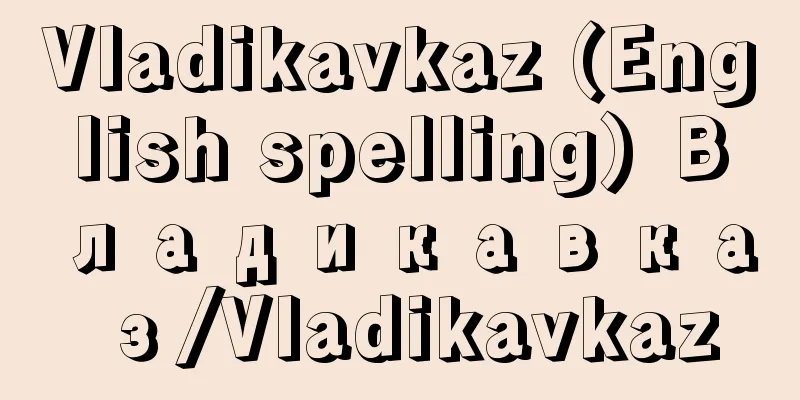Vladikavkaz (English spelling) Владикавказ/Vladikavkaz

|
Located in the southwest of the Russian Federation, it is the capital of the Republic of North Ossetia, which is part of the federation. Population: 310,600 (1999). It was called Ordzhonikidze from 1931 to 1944, Dzaudzhikau from 1944 to 1954, and then Ordzhonikidze again from 1954 to 1991. After the collapse of the Soviet Union (December 1991), the name of Vladikavkaz, which was used before 1931, was revived. It is located in the northern foothills of the Great Caucasus Mountains, in the valley of the Terek River. It originated as a Russian military fortified village built near Dzaudzhikau, which was inhabited by Ossetians, to defend the Georgian military road. It was incorporated as a city in 1860, and became the location of the district office in 1863. It was bustling with trade and the military. There are factories producing electrical equipment, automotive electrical parts, railroad car repairs, zinc electrorefining, chemical fibers, shoes, furniture, etc. It is the center of North Ossetian ethnic culture, and is home to the North Oceania National University, Agricultural University, and Industrial University, as well as the Medical University, Applied Psychology University, and Sociology University, as well as Ossetian and Russian theaters, symphony orchestras, and art museums. A Sunni Islamic mosque has also been preserved. The city retains the square land layout of Russian colonial cities, and is beautifully landscaped with greenery. A 23-kilometer railway branch line connects the city to the main line between Baku and Rostov-on-Don, and the same section is also served by a main road. [Ueno Toshihiko] [References] | | |Source: Shogakukan Encyclopedia Nipponica About Encyclopedia Nipponica Information | Legend |
|
ロシア連邦南西部に位置し、同連邦に属する北オセチア共和国の首都。人口31万0600(1999)。1931~1944年にはオルジョニキーゼОрджоникидзе/Ordzhonikidze、1944~1954年にはザウジカウДзауджикау/Dzaudzhikauとよばれ、1954~1991年はふたたびオルジョニキーゼに戻ったが、ソ連崩壊(1991年12月)後は1931年以前の名称であるウラジカフカスの名が復活した。大カフカス山脈北麓(ほくろく)にあり、テレク川の谷に位置する。ジョージア(グルジア)軍用道路を守備するため、オセット(オセチア)人が居住するザウジカウ近傍に建設したロシア軍の要塞(ようさい)村落が起源である。1860年市制を敷き、1863年から郡役所所在地となり、交易と駐在軍でにぎわった。電気機器、自動車電装品、鉄道車両修理、亜鉛の電気精錬、化学繊維、靴、家具などの工場がある。北オセチア民族文化の中心地で、北オセアニア国立大学、農業大学、工業大学のほか、単科大学として医科大学、応用心理学大学、社会学大学があり、オセット語とロシア語のそれぞれの劇場、交響楽団、美術館が置かれている。スンニー派のイスラム教寺院も保存されている。市街はロシアの植民都市の形態である方形地割を残し、緑樹が美しい。当市から鉄道支線23キロメートルで、バクー―ロストフ・ナ・ドヌー間の幹線に接続し、道路も同区間の幹線が通じている。 [上野俊彦] [参照項目] | | |出典 小学館 日本大百科全書(ニッポニカ)日本大百科全書(ニッポニカ)について 情報 | 凡例 |
>>: Vladivostok (English spelling) Владивосток/Vladivostok
Recommend
Solubilized solution
...Surfactants also have the characteristic that ...
Glans - Kitou
A particularly swollen part at the tip of the pen...
Oxadiazon - Oxadiazon
...Simazine and atrazine in particular are known ...
Penicillida jenynsii (English spelling)
…About 200 species of spider flies are known from...
Social welfare
Social welfare is a multi-faceted concept. Accord...
Attack and defense methods
In civil litigation, the statements made by the p...
Yoshiaki Hineno
1587-1656 A daimyo in the early Edo period. Born ...
Fence - Kaki
A structure erected above ground to secure housin...
Yuki Magosaburou - Yuki Magosaburou
A stage name for a string puppeteer. The first wa...
American
...In April 1901, the paper, which had been fierc...
Shashokudan (English spelling) She-ji-tan
In China, an altar for worshiping the Sacred God. ...
"Iberia" (Debussy) - Iberia
...The second marriage produced a child, who insp...
Hypotonia - Muscle tone
...Also, predictive movements such as touching th...
veṇu (English spelling) venu
…It is made of bamboo and has a simple structure ...
Uncaria genus - Uncaria genus
…It is distributed in southwestern Japan and Chin...









